Grace Elliot's Blog: 'Familiar Felines.' , page 13
January 22, 2014
King Charles I at Carisbrooke Castle
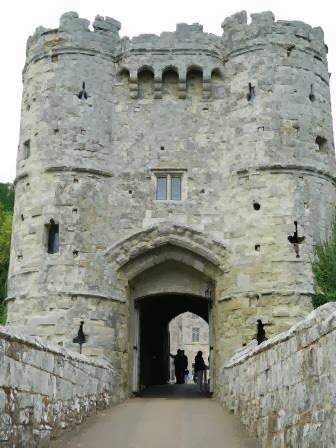 The imposing entrance to Carisbrooke CastleThis January it is 365 years since King Charles I was executed. Last week we retraced his final steps to the scaffold outside the Banqueting House, London, but this week we visit Carisbrooke Castle, where the doomed king was imprisoned for 10 months from 1647 – 1648.
The imposing entrance to Carisbrooke CastleThis January it is 365 years since King Charles I was executed. Last week we retraced his final steps to the scaffold outside the Banqueting House, London, but this week we visit Carisbrooke Castle, where the doomed king was imprisoned for 10 months from 1647 – 1648.
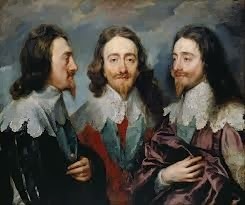 King Charles I After his defeat in the English Civil War, Charles surrendered to the Scots. But after months of negotiation with the English, the Scots handed the king over to parliamentary commissioners in January 1647 in exchange for £100,000. Charles was held prisoner at Newmarket, Oatlands and Hampton Court. However, Charles escaped from the later and made his way to the Isle of Wight, perhaps with the intention of fleeing to France. The king made contact the governor of the Isle of Wight, Colonel Robert Hammond, who although was a parliamentarian Charles believed he had sympathy with the royalist cause - but he was wrong. Hammond confined Charles in Carisbrooke Castle and informed the parliamentary authorities.
King Charles I After his defeat in the English Civil War, Charles surrendered to the Scots. But after months of negotiation with the English, the Scots handed the king over to parliamentary commissioners in January 1647 in exchange for £100,000. Charles was held prisoner at Newmarket, Oatlands and Hampton Court. However, Charles escaped from the later and made his way to the Isle of Wight, perhaps with the intention of fleeing to France. The king made contact the governor of the Isle of Wight, Colonel Robert Hammond, who although was a parliamentarian Charles believed he had sympathy with the royalist cause - but he was wrong. Hammond confined Charles in Carisbrooke Castle and informed the parliamentary authorities.  The view from the ramparts.
The view from the ramparts.Charles regularly walked along the ramparts for exercise. Initially, Charles was housed comfortably in the Constable’s Lodging and allowed the freedom to roam, but plots to renew the war and escape attempts meant he was placed under closer supervision. Even so, Hammond treated him as an honoured guest and imported furniture from Hampton Court for the king's comfort, as well as dozens of servants. Charles held 20 course meals in the Great Hall and a bowling green created on the field used to drill troops.
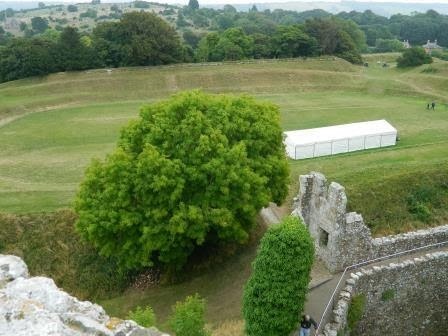 This field (with the white tent) was the drill ground for the castle militia.
This field (with the white tent) was the drill ground for the castle militia.It was converted to a bowling green for Charles. Charles' first escape attempt was to climb through the window of his bedchamber – but he suffered the indignity of getting stuck in the bars. He was moved to different rooms in a part of the castle built 60 years before by a cousin of Elizabeth I, and placed under armed guard.
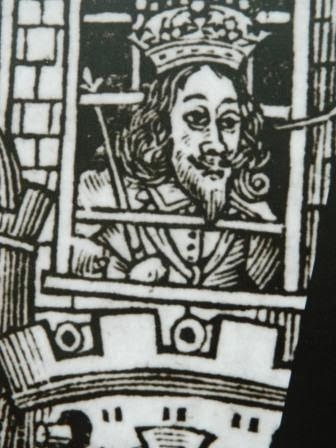 Every chance was taken to ridicule Charles -
Every chance was taken to ridicule Charles -shown here stuck in the window Undeterred, with the aid of his page (with the magnificent name of Henry Firebrace), he made two more attempts. On the night of 20th March 1648 Charles successfully climbed of a window – to be betrayed by two guards who had taken money to let him escape and then turned him in.
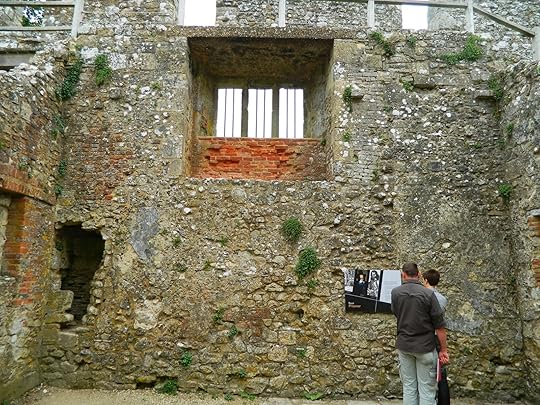 This is the window that Charles successfully escaped from -
This is the window that Charles successfully escaped from -only to be betrayed by two guards in his pay. Whilst at Carisbrooke, Charles continued plot and scheme – broking a secret treaty with the Scots – they undertook to invade England of Charles’ behalf and restore his throne, in exchange for establishing Presbyterianism in England.
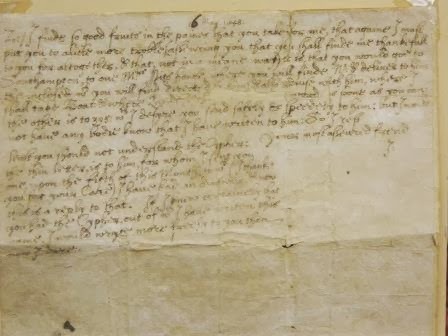 Part of the correspondence (in cipher) between Charles
Part of the correspondence (in cipher) between Charles and the Scots.The ensuing skirmishes were put down by the New Model Army and the Scots finally defeated August 1648 at the Battle of Preston.
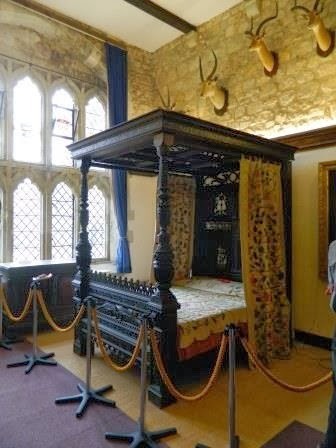 Charles' bedchamber November 1647 to April 1648
Charles' bedchamber November 1647 to April 1648These are not the original furnishings -
but are similar to what Charles had brought from Hampton Court. The only option left open to Charles was to negotiate with Parliament. On 5 December 1648, the majority voted to continue negotiations but Oliver Cromwell wasn’t prepared to take the risk of people uniting behind their one time monarch . Cromwell purged those sympathetic to Charles from Parliament, leaving those who would eventually put him on trial and send him to be executed on a scaffold outside the Banqueting House, London – 30 January 1649.
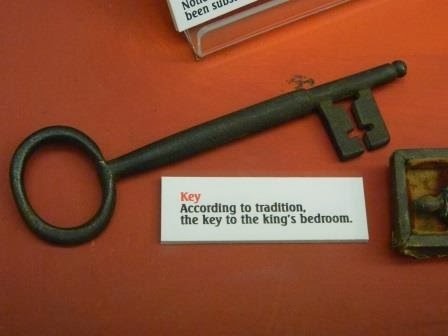 The post about Charles' execution can be found here:
The post about Charles' execution can be found here:London Then and Now: Charles I's Execution
And finally....10 days to release on 1st February - look who's taking a sneak peek at an advance review copy of The Ringmaster's Daughter!
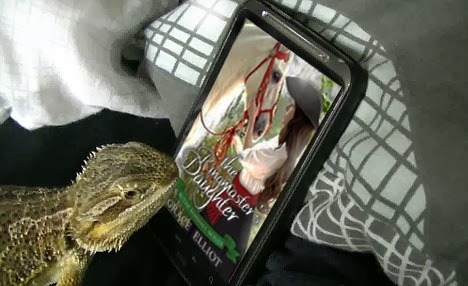
Published on January 22, 2014 00:50
January 15, 2014
London Then and Now: King Charles I's Execution
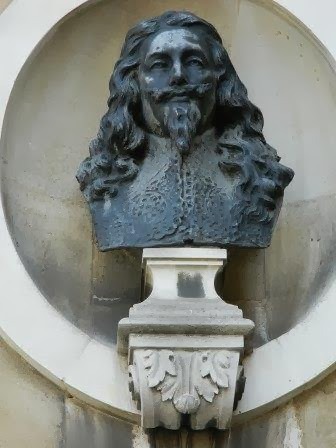 The statue of King Charles I - in memory of his execution. The end of this month marks the 365th anniversary of the execution of King Charles I. He was put on trial on January 1st, 1640 and died on to 30th - charged with:“[being a] tyrant, traitor and murderer; and a public and implacable enemy to the Commonwealth of England.”
The statue of King Charles I - in memory of his execution. The end of this month marks the 365th anniversary of the execution of King Charles I. He was put on trial on January 1st, 1640 and died on to 30th - charged with:“[being a] tyrant, traitor and murderer; and a public and implacable enemy to the Commonwealth of England.”
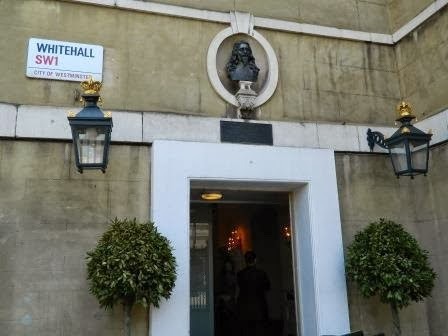 The statue is mounted above the entrance to
The statue is mounted above the entrance tothe Banqueting House, Whitehall
http://www.hrp.org.uk/BanquetingHouse/ Last summer I visited the Banqueting House, Whitehall and noticed a memorial statue to the dead king. It transpired that the scaffold on which he died was erected outside the Banqueting House and his final moments were spent inside that building. That gave me a real sense of being close to history and in this post I share some of the pictures I took – along with how things looked in Charles’ day.
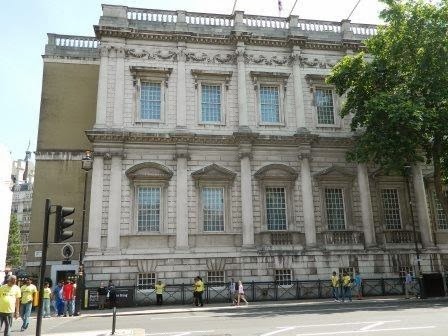 The Banqueting House in the modern day Cromwell was the victor in the English Civil War and his Parliamentarian army imprisoned the reigning monarch, accusing him of treason. “Out of a wicked design to erect and uphold in himself an unlimited and tyrannical power to rule according to his will, and to overthrow the rights and liberties of the people of England.”However, in English law there was nothing applicable to deal with the trial of a king and so Cromwell called in a Dutch lawyer Isaac Dorislaus. The later used a precedent in ancient Roman law which stated a tyrant (the king) could be legally overthrown by a military body (the government).
The Banqueting House in the modern day Cromwell was the victor in the English Civil War and his Parliamentarian army imprisoned the reigning monarch, accusing him of treason. “Out of a wicked design to erect and uphold in himself an unlimited and tyrannical power to rule according to his will, and to overthrow the rights and liberties of the people of England.”However, in English law there was nothing applicable to deal with the trial of a king and so Cromwell called in a Dutch lawyer Isaac Dorislaus. The later used a precedent in ancient Roman law which stated a tyrant (the king) could be legally overthrown by a military body (the government).
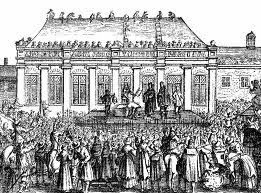 The Banqueting House - 30th January 1649 The Chief Judge was John Bradshaw (it appears he feared assassination because he made a special hat lined with metal to protect his head from attack.) Charles refused to acknowledge the legality of the court and refused to remove his hat. To some people, this confirmed the king’s arrogance that even when on trial for his life, he thought himself superior.
The Banqueting House - 30th January 1649 The Chief Judge was John Bradshaw (it appears he feared assassination because he made a special hat lined with metal to protect his head from attack.) Charles refused to acknowledge the legality of the court and refused to remove his hat. To some people, this confirmed the king’s arrogance that even when on trial for his life, he thought himself superior.

Charles was found guilty and sentenced to execution on Tuesday, 30th January, 1649. He had a last meal of bread and wine, and took a short walk around St James’ Park with his favorite dog. One story says that his black cat, Lucky, went missing on that day (not so lucky…)
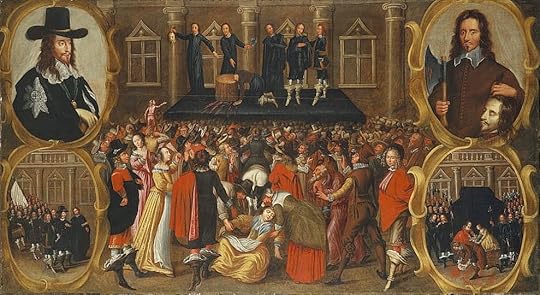
Neither an executioner nor the executioner’s block could be found, so a stranger had to be enlisted – he was paid £100 and allowed to wear a mask to protect his anonymity. At 2 o’clock in the afternoon Charles was led through the Banqueting House, through a window and onto a scaffold draped in black, in Whitehall. The king wore thick underclothes because he was worried if he shivered with cold, the crowd would think him frightened.
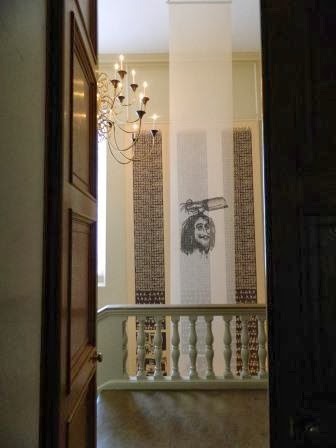 Inside the Banqueting House -
Inside the Banqueting House -The last landing that Charles I saw before he died.He conducted himself with composure and gave his cloak to Dr Juxon, the Bishop of London, saying.“I go from to corruptible to an incorruptible crown where no disturbance can be.”He lay full length, placed his head on a low block and with one strike the executioner severed his head from his body. When he died a great groan went through the crowd.“Such a groan by thousands then present, as I never heard before and I desire I may never hear again.”
 Inside the Banqueting House -
Inside the Banqueting House -Charles would have used these very stairs in his final journey on
his way to execution. The dignity with which the king conducted himself on the scaffold and the realization that God’s anointed sovereign had died by human hand, caused a great wave of sympathy for the dead monarch. He was later recognized as a martyr and 30 January remembered as Charles the Martyr day.[With thanks to the Historic Royal Palaces organisation - http://www.hrp.org.uk/BanquetingHouse/ ]
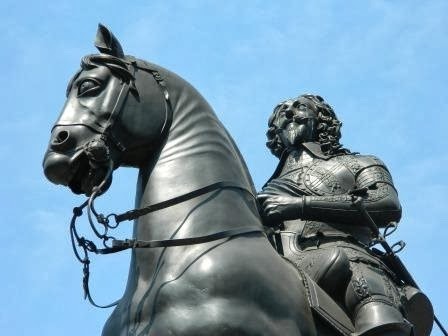 A statue of Charles I in Whitehall
A statue of Charles I in WhitehallAll photographs taken by the author.Next week - Charles I's time imprisoned on the Isle of Wight.
Published on January 15, 2014 01:33
January 12, 2014
Welcome! Maria Grace -author of Regency Romance
I am probably the odd one out. I actually love the research process. It is probably one of my favorite things about writing historical fiction. As a kid, I loved to read reproductions of old cookbooks—and honestly I still do. Vintage cookbooks often offer insight into daily household activities from eras long past. Knowing what the spaces people lived in and how they cooked, ate, cleaned their homes, their clothes and themselves, the medicines they prepared and the maladies they prepared them for all paint such a vivid picture for me of what life was like, I feel a little transported to that era myself.
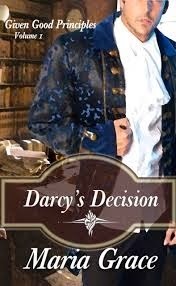 Top 100 Regency romance!That is the crux of world-building, a skill every writer must have whether they are creating their worlds, whether fantastical ones or recreating a historical ones. So I indulge my researching-itch with period references whenever I can. Digitized period books have made my efforts so much easier. I now have hundreds of such references on my hard drive, with access on my phone if I really want. Sometimes it is a bit of a head trip, referencing a 1794 cookbook for instructions on cleaning fruit juice stains from silk using the WiFi connection on my cellphone! The things writers do for their craft!
Top 100 Regency romance!That is the crux of world-building, a skill every writer must have whether they are creating their worlds, whether fantastical ones or recreating a historical ones. So I indulge my researching-itch with period references whenever I can. Digitized period books have made my efforts so much easier. I now have hundreds of such references on my hard drive, with access on my phone if I really want. Sometimes it is a bit of a head trip, referencing a 1794 cookbook for instructions on cleaning fruit juice stains from silk using the WiFi connection on my cellphone! The things writers do for their craft!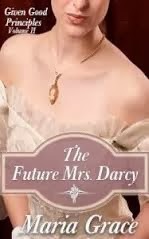 Top 100 historicalI frequently find myself searching out little details that I could otherwise gloss over, since, really, they aren’t THAT important to the story. Things like specific decorative items or furnishings of rooms, what was served at meals or teas, what did they taste and smell like. Were they just place on the table, or was there some particular way they were presented? Were there special serving vessels used or just everyday dishes and did those dishes communicate anything about the host or hostess. These are little things which don’t necessarily carry the plot, but they can transport the reader into the story world and that is important to me.
Top 100 historicalI frequently find myself searching out little details that I could otherwise gloss over, since, really, they aren’t THAT important to the story. Things like specific decorative items or furnishings of rooms, what was served at meals or teas, what did they taste and smell like. Were they just place on the table, or was there some particular way they were presented? Were there special serving vessels used or just everyday dishes and did those dishes communicate anything about the host or hostess. These are little things which don’t necessarily carry the plot, but they can transport the reader into the story world and that is important to me.In my most recent book, my characters spend a great deal of time in London, necessitating research into what kind of homes people occupied in Regency London. I would love to share with you some of what I learned.
Georgian Terrace Houses

Terrace houses dominated the London landscape during the Regency. Almost the entire London population, rich and poor alike, line in one or another version of the terrace house. The term terrace was borrowed from garden terraces and described streets of houses with uniform fronts and height that single elevation to the street.
The design of these houses varied little whether located in London, Bath, Dublin or Edinburgh though the exterior facades might differ with local stone or brick, stucco or fancy ornamentation. Georgian terraces built along main urban thoroughfares often incorporated ground-floor shops with residences in the upper stories.
History of Terrace Houses
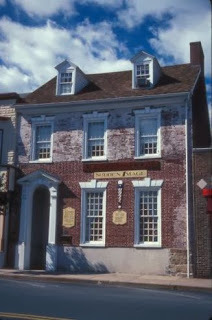
The Great Fire of London in 1666 brought about the first of a series of Building Acts (1667, 1707, 1709 and 1774). These acts set building requirements to reduce the risk of fire spreading. Although they regulated London buildings specifically, they also influenced building style in many other cities.
The initial 1667 Act required brick or stone to be used for all external and party walls eliminating the typical timber fronts of the Tudor and early Stuart houses. The 1707 Act eliminated thick timber cornices. The 1709 Act required that window frames be set back behind the building line. The 1774 Act required the use of stone or brick, specified street width, the size and layout of the houses, floor to ceiling heights and controlled decoration on facades even more rigidly.
This final building act also divided terrace houses into four classes, defined by the number of stories, ceiling heights, road widths and wall thicknesses. At the very bottom of the scale, fourth rate houses were those built in large numbers by speculative developers from the late eighteenth century in response to industrial development in towns like Liverpool and Manchester. These houses were often built back-to-back in tiny yards pressed behind street frontages. In contrast, some of the wealthiest people in the country owned palatial, first rate terraced houses in prestigious locales like Belgrave Square and Carlton House Terrace.
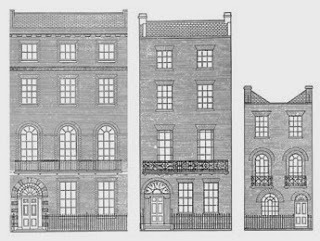
First rate houses faced streets and lanes, were worth over £850 per year in ground rent and occupied over 900 square feet of ground space. Keep in mind, these houses usually had four stories, plus a basement so they were frequently more than 4500 square feet on the inside. Second rate houses faced streets, notable lanes, and the River Thames. They were worth between £350 and £850 in ground rent and had an exterior foot print of 500-900 square feet.
Third rate houses faced principal streets, rented for £150-£300 and occupied 350-500 square feet ground space. The most humble terrace houses, the fourth rate house, was worth less than £150 per year in rent and occupied less than 350 square feet of land. These houses might be only three stories instead of four and stood in yards and courts, apart from easy street access.
Terrace House Design
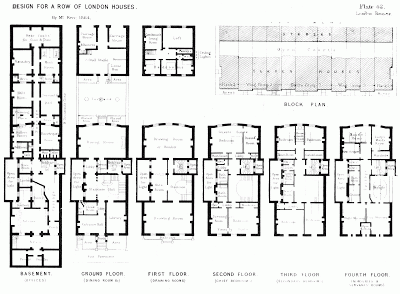 Whatever the size of the terrace house, the general plan was always the same. There would be one room at the back and one at the front of each floor with a passage and staircase at one side. The rooms were sometimes divided into smaller units.
Whatever the size of the terrace house, the general plan was always the same. There would be one room at the back and one at the front of each floor with a passage and staircase at one side. The rooms were sometimes divided into smaller units. BasementsAll except the poorest houses had basements. Most of the service rooms would be in the basement which was often accessed through an open area in front with steps leading down to it. The open area would give light to the kitchen windows and opened onto storage vaults under the pavement. Small wells around the house would allow for windows to light other subterranean rooms including back staircases and household offices.
A variety of offices might be housed in the basement include the scullery (a small room for washing and story dishes and kitchen equipment); pantry and larder for food storage; butler's pantry and quarters, safe, and cleaning-room for the silver; housekeeper's-office; still-room for drying and preparing foods and herbs for storage, medicinal formulations, soap, ect; servants'-hall where servants might eat and socialize; a wine-cellar and a closet for beer; laundry and housemaid's-closet for linen storage; quarters for housekeeper, cook and possibly men-servants; and vaults for coals and dust. Even in the largest of house not all these rooms might be present and if present, they could be very small, with many of them packed tightly into the limited basement space.
A lift, also called a dumbwaiter, might be employed to bring food and other items up from the basement to the principle floors of the house. The lift might be located in a back stair well rather than opening directly into a room of the house.
Ground FloorThe best rooms in a townhouse were on the ground and first floor and faced the back of the house, away from the dirt and noise of the street. These included drawing rooms, parlors and dining rooms.
Drawing rooms were a place near the front door for accessibility in greeting visitors. The women of the house and their female guests would also use the drawing room as a place to retreat after dinner, so they would be near the dining room as well. In contrast, the more modest parlor was a private room for the family’s enjoyment.
In large houses, the ground floor might also house an entrance hall, cloak-room, storage closet, and library or office. These would be more likely to face the street side of the house.
The first floorThe first floor contained large rooms for entertaining. The rooms might be used for card paying, parlor games and dancing. Large or folding doors might connect smaller rooms so that they could be opened to create larger spaces. Principle bedrooms might also occupy this floor, usually located in the front (street side) of the house.
The second floorThe more modest second floor featured secondary bedrooms for children, or perhaps a lodgers or guests. The rooms on this floor would be more simply furnished and decorated than those on lower floors. Bathing rooms, closets and linen storage rooms for both cleaned and soiled lines might also be located on this floor.
The atticThe rooms on the highest floor were reserved servants, who often used beds that were let down from the wall like murphy beds. Nursery suits and storage rooms might also be located here. These rooms were cheaply painted and furnished.
OutbuildingsLarge townhomes might also include outbuilding behind the house. Stables and carriage houses might also feature quarters for coachmen and grooms for the horses.
Even though there was a great deal of similarity between the terraced homes, the differences were important reflections of the wealth and status of the occupants of these home and offer a delicious variety of details for world building and story crafting.
References
Characteristics of the Georgian Town House
The Ideal House
Kerr, Robert. The Gentleman's House (1871, 3ed.)
Lane, Maggie. Jane Austen and Food. Hambledon (1995)
Le Faye, Deirdre. Jane Austen: The World of Her Novels. Harry N. Abrams (2002)
London Architecture
Parissien, Steven. Regency Style. Phaidon Press Limited (2000)
Sabor, Peter (editor). The Cambridge Edition of the Juvenilia. Cambridge University Press (2006)
Spencer-Churchill, Henrietta. Classic Georgian Style. Collins & Brown (1997)
Summerson, John. Georgian London. Yale University Press (2003) Town Houses
Yorke, Trevor. Georgian & Regency Houses Explained. Countryside Books (2007)
Yorke, Trevor. Regency House Styles. Countryside Books (2013)
~~~~~~~~~~~
You can find my most recent book
Twelfth Night at Longbourn
at:Amazon kindle~NOOK~KOBO~Gumroads (pdf) Amazon Paperback available soon
Connect with Maria Grace Facebook~Amazon~Website~Twitter
Twelfth Night —a night for wondrous things to happen.
At least for other people.
In the months after her sisters' weddings, nothing has gone well for Kitty Bennet. Since Lydia’s infamous elopement, her friends have abandoned her, and Longbourn is more prison than home. Not even Elizabeth's new status as Mrs. Darcy of Pemberley can repair the damage to Kitty’s reputation. More than anything else, she wishes to leave the plain ordinary Kitty behind and become Catherine Bennet, a proper young lady.
Her only ray of hope is an invitation to Pemberley for the holidays. Perhaps there she might escape the effects of her sister’s shame.
Getting to Pemberley is not as simple as it sounds. First she must navigate the perils of London society, the moods of Georgiana Darcy, and the chance encounter with the man who once broke her heart. Perhaps though, as Catherine, she might prove herself worthy of that gentleman’s regard.
But, in an instant all her hopes are dashed, and her dreams of becoming Catherine evaporate. Will Kitty Bennet's inner strength be enough to bring her heart's desire?
On an ordinary night perhaps not, but on Twelfth Night, it just might be enough.
Author bio
Though Maria Grace has been writing fiction since she was ten years old, those early efforts happily reside in a file drawer and are unlikely to see the light of day again, for which many are grateful.
She has one husband, two graduate degrees and two black belts, three sons, four undergraduate majors, five nieces, six cats, seven Regency-era fiction projects and notes for eight more writing projects in progress. To round out the list, she cooks for nine in order to accommodate the growing boys and usually makes ten meals at a time so she only cooks twice a month.
Published on January 12, 2014 01:01
January 8, 2014
London Then and Now: Vauxhall Pleasure Gardens
 An overview of the Vauxhall Pleasure Gardens in the 18th century.
An overview of the Vauxhall Pleasure Gardens in the 18th century.Photo courtesy of the Foundling MuseumEver since visiting an exhibition about the Vauxhall Pleasure Gardens at The Foundling Museum, the history of the gardens has fascinated me. So for my first foray of the New Year, I visited the site of the old Vauxhall Pleasure Gardens to see if any of the great 18th century attraction has survived to the present day.
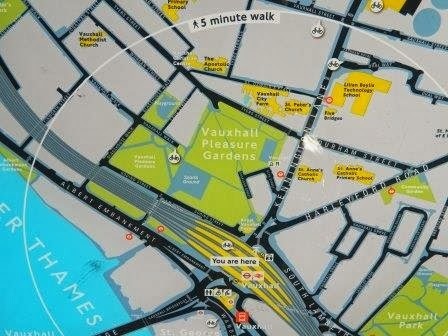 'You are Here' - arriving at Vauxhall tube station.
'You are Here' - arriving at Vauxhall tube station.The site of the old pleasure gardens just a short walk away.On the south bank of the Thames, the gardens' popularity peeked in the Georgian era. Under the proprietorship of Jonathan Tyers, they grew from the equivalent of a pleasant (well, if you ignored the prostitutes and pickpockets!) country walk near a tavern, to a trendy place of entertainment with sensational lights, exotic buildings, first class music, dancing and romantic walks. Tyers was an entrepreneur and ahead of his time because he had a canny talent for advertising and marketing.
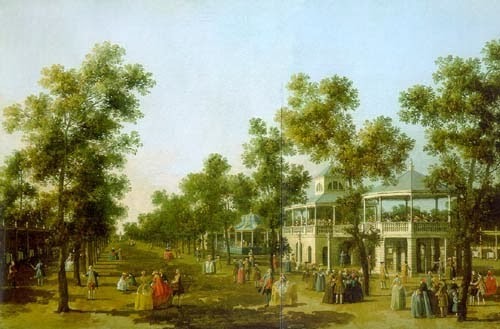 The Grand Walk, Vauxhall - as portrayed in this
The Grand Walk, Vauxhall - as portrayed in thispainting by Canaletto.Arriving at Vauxhall station, my first task was to orientate myself. Needless to say the area looks hugely different to in Jonathan Tyers day. Part of the reason for Vauxhall's success was that the gardens were an earthly 'Elysium' - a verdant paradise away from the hustle, smells and congestion of an expanding city. This is the sight that greeted me...
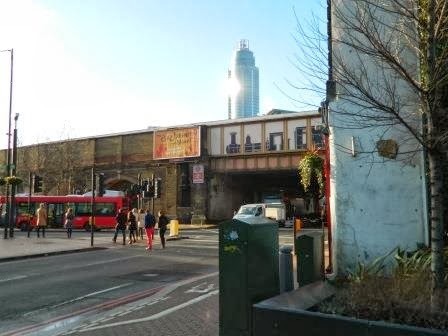 Here I'm standing with my back to the current entrance
Here I'm standing with my back to the current entranceand facing towards the Thames. The railway line is visible leading
to the station on the left of the picture.The current entrance is view an innocuous pavement with two tall columns (not at all sure what the significance of the columns are -it's almost as if someone thought they were a good idea at the time)
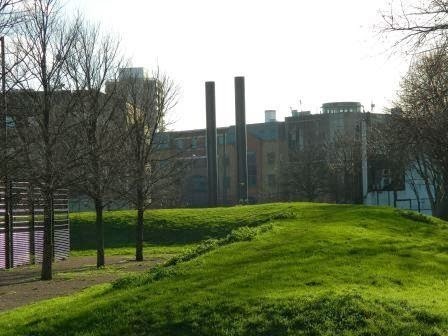 Standing in the gardens facing the new entrance.
Standing in the gardens facing the new entrance.Note the two tall columns marking the entry.However, in the 18th century the main entrance was through the Proprietor's House, along what is now Goding Street.
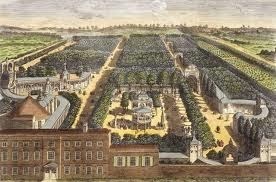 The original entrance ran parallel to the modern railway line (see pic above)
The original entrance ran parallel to the modern railway line (see pic above)Visitors passed through the main entrance to the Proprietor's House
which is the building to the left of this painting.
The original gardens closed in mid-Victorian times and housing was built on the area. These estates were badly bombed in the Second World War and in the 1950's a decision was made to convert some of the land back to greenery in tribute to the Pleasure Gardens. Because of this, nothing of Tyers gardens remains, but using a variety of old maps (from 1813, 1850) and a present day map, I found as best I could, the equivalent locations. As you will see, things don't compare favourably.
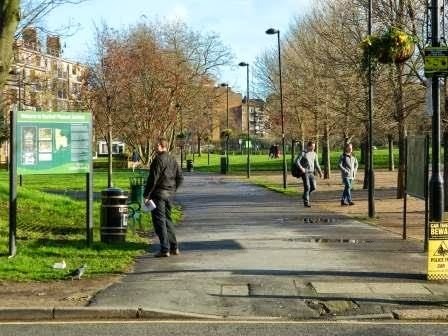 This approximates to where the Proprietor's House was,
This approximates to where the Proprietor's House was,and also the Grand Walk (as shown in the Canaletto painting)
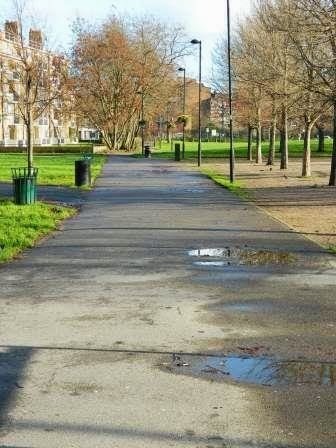 The 'Grand Walk' January 2014What never ceases to surprise me about London is just how close everything is. From the modern gardens you can see the Shard.
The 'Grand Walk' January 2014What never ceases to surprise me about London is just how close everything is. From the modern gardens you can see the Shard.
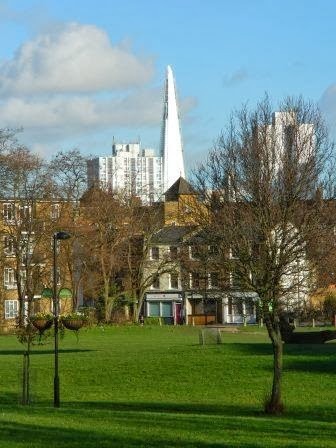 The Shard - centre - as seen from Vauxhall GardensAnd turning around to face the Thames are a number of modern landmarks including MI6's 'secret' offices.
The Shard - centre - as seen from Vauxhall GardensAnd turning around to face the Thames are a number of modern landmarks including MI6's 'secret' offices.
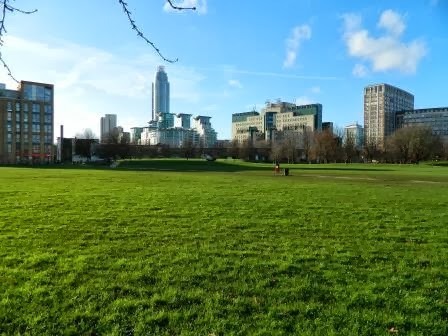 MI6 -to the right of centre.Indeed, the 18th century visitor from London would cross from north of the Thames on a special wherry and land very close to what is the modern MI6 building. (Hubs, who was with me, got very nervous about me taking photos of MI6...)
MI6 -to the right of centre.Indeed, the 18th century visitor from London would cross from north of the Thames on a special wherry and land very close to what is the modern MI6 building. (Hubs, who was with me, got very nervous about me taking photos of MI6...)
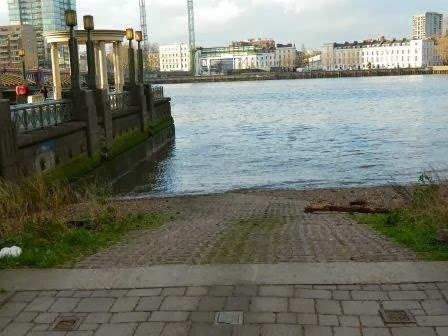 As close as I could find to the original slipway on the Thames.
As close as I could find to the original slipway on the Thames.MI6 to my left ,with the gardens behind me.
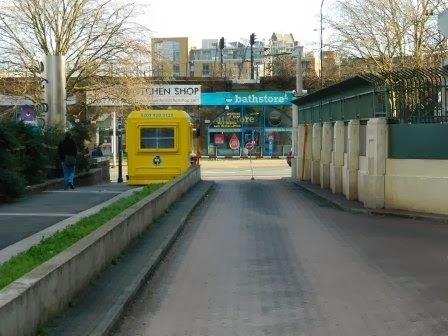 Standing on the same spot but turned through 180 degrees.
Standing on the same spot but turned through 180 degrees.The gardens are behind the 'bathstore'.
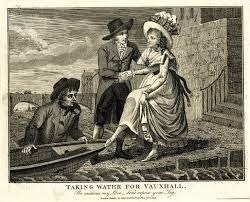 An 18th century visitor landing by wherry,
An 18th century visitor landing by wherry,to visit the gardens.
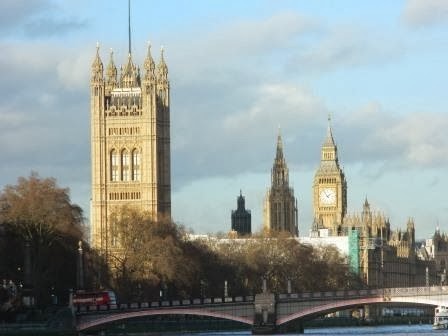 It's not all bad!
It's not all bad!Standing on the slipway, facing the Thames but with the camera pointing
to my right.And finally, Jonathan Tyers loved his creation - the Vauxhall Pleasure Gardens. He was a London man and when he died was buried near his birthplace in Bermondsey. No marked grave exists and so his memory continues in a number of streets in Vauxhall that carry his name
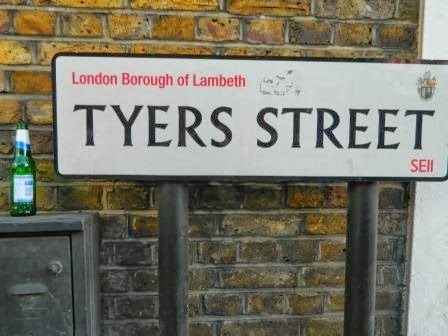
[The gardens are featured in Verity's Lie. They are also the inspiration behind my new series based on the fictional Foxhall Gardens. #1 The Ringmaster's Daughter is released on February 1st, 2014.]
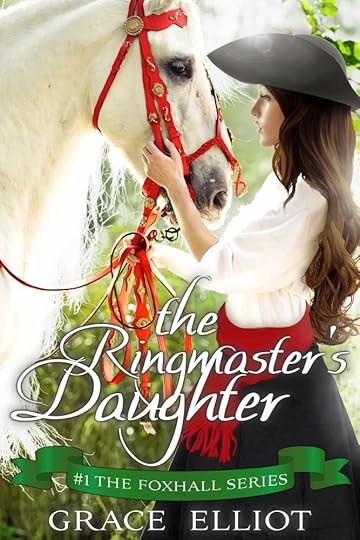
Published on January 08, 2014 01:55
December 31, 2013
Most Viewed Blog Posts of 2013
This New Year's Eve I'd like to wish all visitors to my blog a happy and healthy 2014.
As 2013 draws to an end it seems appropriate to recap on the year gone by - and see which posts had the most views.
So - in reverse order, the 10 most viewed blog posts here on 'Fall in Love with History.'
Is there a post that sticks in your mind?
If so, it would be great if you'd leave a comment and share which posts appeal to you and why.
Grace x
PS - Click the photo for a link to the post.
#10 - Cats and the Possessed
 Widget - summer 2013#9 - Tower of London: Polar Bears in the Thames
Widget - summer 2013#9 - Tower of London: Polar Bears in the Thames
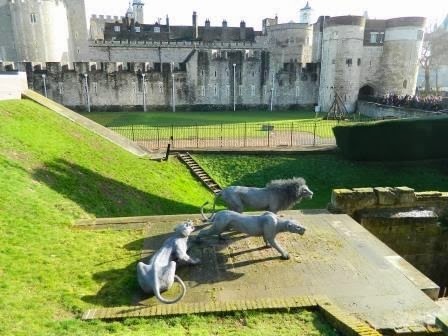 January 2013 I visited the Tower of London
January 2013 I visited the Tower of London
#8 - Bizarre Tudor Deaths
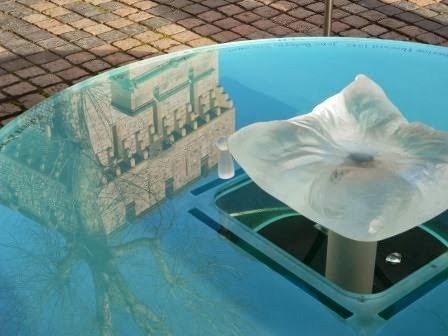 The memorial at the Tower of London to those executed there (including Anne Boleyn)#7 - How Many Wives did Henry VIII have?
The memorial at the Tower of London to those executed there (including Anne Boleyn)#7 - How Many Wives did Henry VIII have?
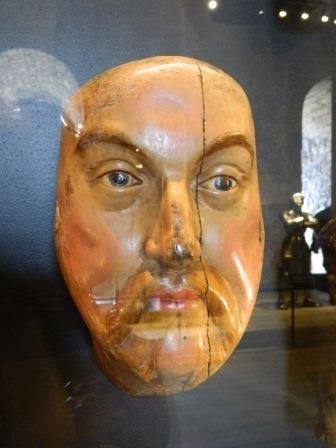 The wooden likeness of Henry VIII, once used to display his armour at the Tower of London's 'Line of Kings' exhibition#6 Kensington Palace: At Home with the King
The wooden likeness of Henry VIII, once used to display his armour at the Tower of London's 'Line of Kings' exhibition#6 Kensington Palace: At Home with the King
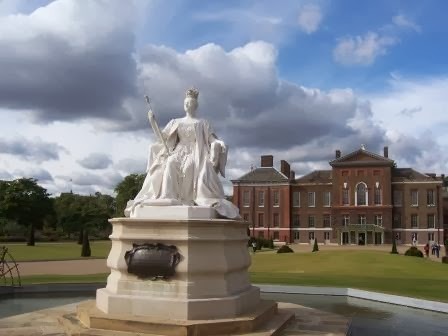 The statue of Queen Victoria outside Kensington Palace#5 - Miraculously Improbable: The Crystal Palace
The statue of Queen Victoria outside Kensington Palace#5 - Miraculously Improbable: The Crystal Palace
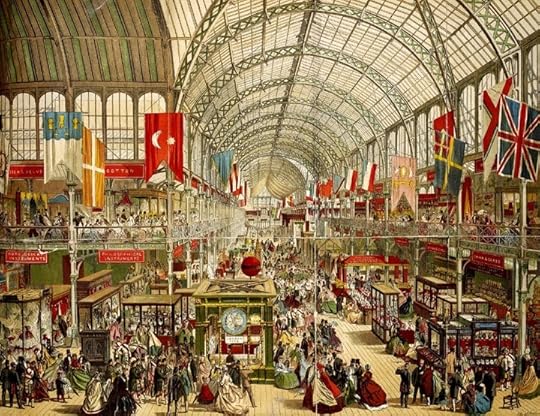 The Great Exhibition -1851, the Crystal Palace#4 - Dog and Cat Diaries
The Great Exhibition -1851, the Crystal Palace#4 - Dog and Cat Diaries
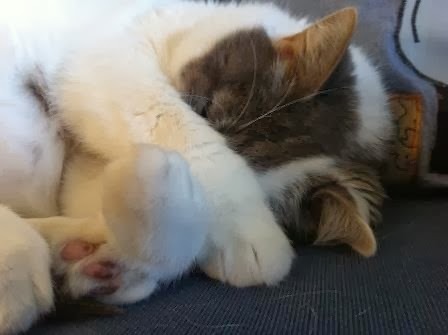 Widget has her own way of coping with stress#3 - Exit Napoleon Pursued by Rabbits
Widget has her own way of coping with stress#3 - Exit Napoleon Pursued by Rabbits
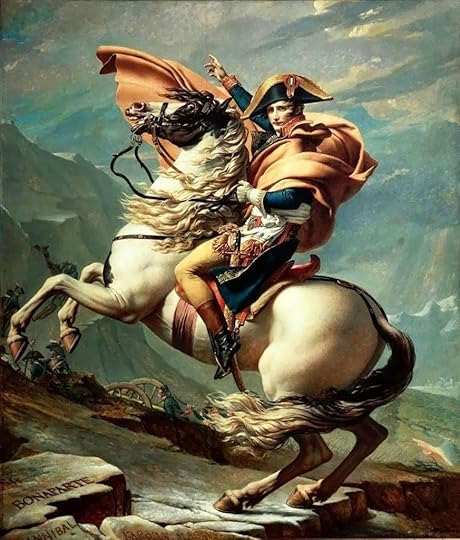 It turns out Napoleon was bested by rabbits...#2 - London Bridge Legends
It turns out Napoleon was bested by rabbits...#2 - London Bridge Legends
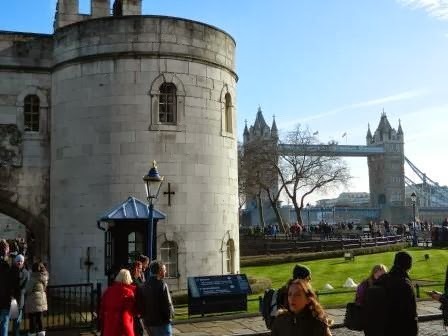 The Tower of London on the left and Tower Bridge (yes, I know - not London Bridge) on the right#1 - Cats Eyes: Seeing is Believing
The Tower of London on the left and Tower Bridge (yes, I know - not London Bridge) on the right#1 - Cats Eyes: Seeing is Believing
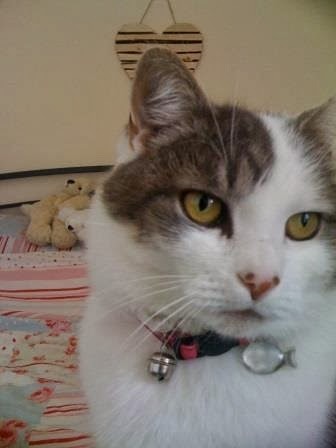 For the second year running, a piece about reflective road studs is the most viewed post!Here's to 2014!
For the second year running, a piece about reflective road studs is the most viewed post!Here's to 2014!
G x
As 2013 draws to an end it seems appropriate to recap on the year gone by - and see which posts had the most views.
So - in reverse order, the 10 most viewed blog posts here on 'Fall in Love with History.'
Is there a post that sticks in your mind?
If so, it would be great if you'd leave a comment and share which posts appeal to you and why.
Grace x
PS - Click the photo for a link to the post.
#10 - Cats and the Possessed
 Widget - summer 2013#9 - Tower of London: Polar Bears in the Thames
Widget - summer 2013#9 - Tower of London: Polar Bears in the Thames January 2013 I visited the Tower of London
January 2013 I visited the Tower of London#8 - Bizarre Tudor Deaths
 The memorial at the Tower of London to those executed there (including Anne Boleyn)#7 - How Many Wives did Henry VIII have?
The memorial at the Tower of London to those executed there (including Anne Boleyn)#7 - How Many Wives did Henry VIII have? The wooden likeness of Henry VIII, once used to display his armour at the Tower of London's 'Line of Kings' exhibition#6 Kensington Palace: At Home with the King
The wooden likeness of Henry VIII, once used to display his armour at the Tower of London's 'Line of Kings' exhibition#6 Kensington Palace: At Home with the King The statue of Queen Victoria outside Kensington Palace#5 - Miraculously Improbable: The Crystal Palace
The statue of Queen Victoria outside Kensington Palace#5 - Miraculously Improbable: The Crystal Palace The Great Exhibition -1851, the Crystal Palace#4 - Dog and Cat Diaries
The Great Exhibition -1851, the Crystal Palace#4 - Dog and Cat Diaries Widget has her own way of coping with stress#3 - Exit Napoleon Pursued by Rabbits
Widget has her own way of coping with stress#3 - Exit Napoleon Pursued by Rabbits It turns out Napoleon was bested by rabbits...#2 - London Bridge Legends
It turns out Napoleon was bested by rabbits...#2 - London Bridge Legends The Tower of London on the left and Tower Bridge (yes, I know - not London Bridge) on the right#1 - Cats Eyes: Seeing is Believing
The Tower of London on the left and Tower Bridge (yes, I know - not London Bridge) on the right#1 - Cats Eyes: Seeing is Believing For the second year running, a piece about reflective road studs is the most viewed post!Here's to 2014!
For the second year running, a piece about reflective road studs is the most viewed post!Here's to 2014!G x
Published on December 31, 2013 11:54
December 24, 2013
Christmas Angels on the Isle of Wight
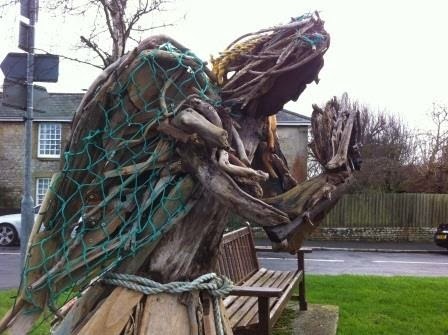 Happy Christmas!
Happy Christmas!This year I'm fortunate to be spending Christmas on the Isle of Wight.
Despite the awful winds and rain we went for a walk round the village and discovered a flock of Christmas angels. To raise money for the local nursery, businesses have erected angels (many life-sized -or should I say out-sized since no one knows how big angels are). So for your Christmas edification I bring you the angels of St Helens.
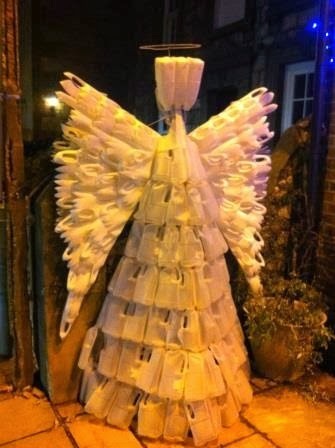 This angel is made from milk cartons!
This angel is made from milk cartons!
 The angel outside the Vine Inn A short walk away on the village green is a driftwood angel - made from pieces of reclaimed wood bolted together.
The angel outside the Vine Inn A short walk away on the village green is a driftwood angel - made from pieces of reclaimed wood bolted together.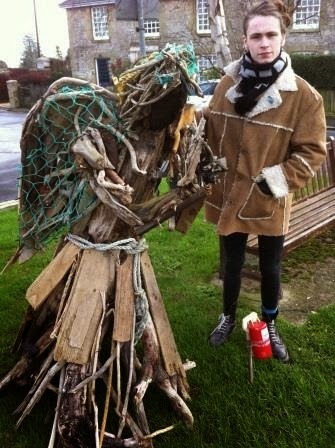 The driftwood angel.In front of a cottage overlooking the green was a 'garden angel' -that looks beautiful both night and day.
The driftwood angel.In front of a cottage overlooking the green was a 'garden angel' -that looks beautiful both night and day.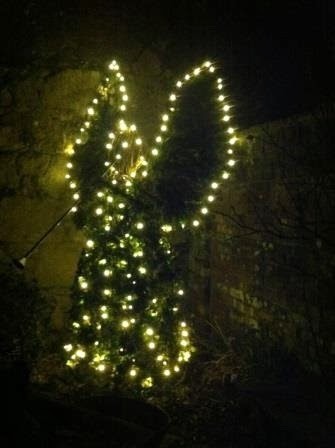
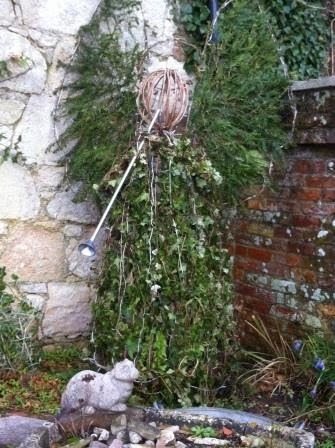
OK, this next one is rather creepy - it put me in mind of a creature from Doctor Who, especially as it takes a while to be certain its not a real person but a model.
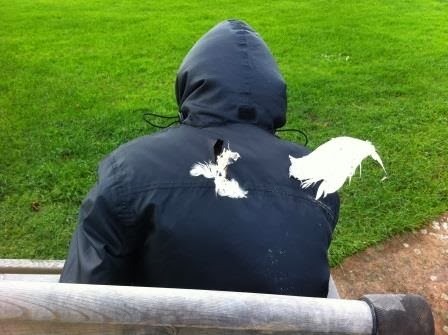 Sporting real feather wings -sadly a little the worse for wear,
Sporting real feather wings -sadly a little the worse for wear,after the stormy conditions.
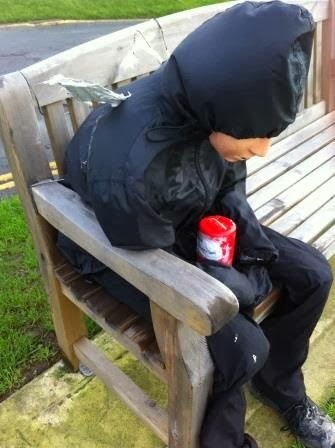
This chap outside the local restaurant is less threatening.
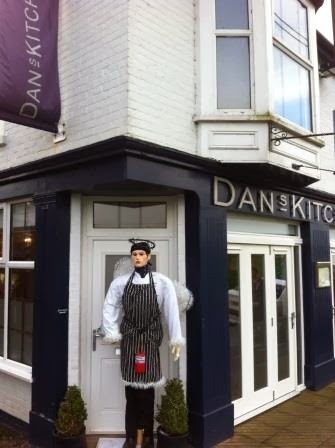
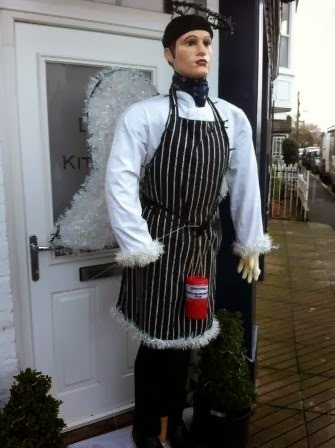
And these happy fellows...
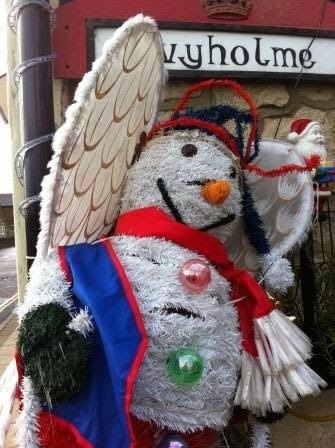
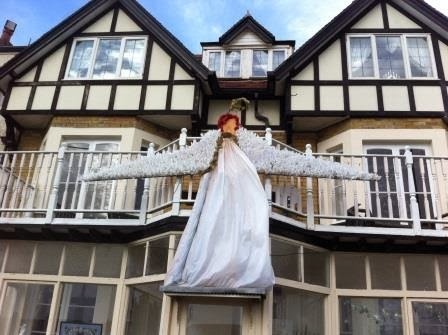
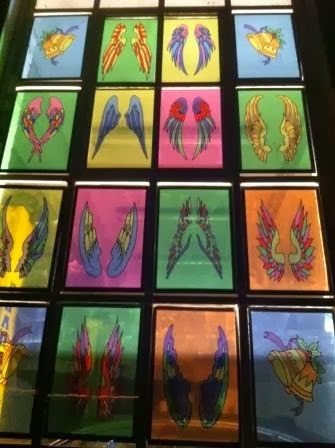

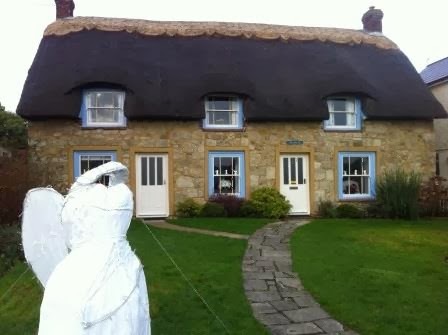
So there we are! A very happy Christmas to you all.
Grace x
PS This fishing village was once a haven for smugglers and the inspiration behind 'Hope's Betrayal'.
Published on December 24, 2013 09:52
December 18, 2013
An Illuminating History...and Christmas Lights

The short days and long nights of December could be dark, dreary and dull were it not for Christmas lights. In my neighbourhood people who outwardly seem quite sane, go uncharacteristically mad and dress their houses with flashing reindeer, illuminated Santas and ropes of lights. Whilst researching my next book I discovered that attaching lights to houses is not a new phenomenon, but has its roots in the 18th century.The first recorded mention of a building decorated with lights was on the occasion of George I’s birthday in 1716. The house in question was that of the royal physician, Hugh Chamberlen and he used 200 lamps to illuminate the façade in tribute to his sovereign.
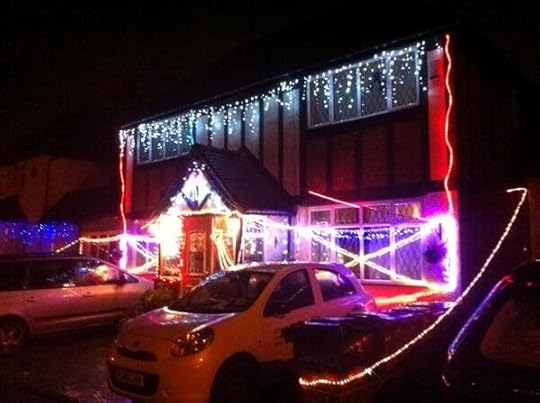 A house I walk past on my way home.The idea seems to have caught on because during the first half of the 18th century courtiers began to light up their homes in honour of the king’s birthday. By the time George III came to the throne not just high-ranking people but the tradesmen linked to the crown adopted the habit and over time to light one’s house became a visible sign of the residents’ allegiance to King and country. Grand buildings were lit with lanterns arranged in complex designs attached to scaffolding whilst humbler abodes were content to show their solidarity with a few candles in the front room window.“Being the King’s Birthday…In the evening there were the usual illuminations….the mob made all the coachmen and footmen which pass’d pull off their hats and cry ‘God save the King’…”June 4th 1777
A house I walk past on my way home.The idea seems to have caught on because during the first half of the 18th century courtiers began to light up their homes in honour of the king’s birthday. By the time George III came to the throne not just high-ranking people but the tradesmen linked to the crown adopted the habit and over time to light one’s house became a visible sign of the residents’ allegiance to King and country. Grand buildings were lit with lanterns arranged in complex designs attached to scaffolding whilst humbler abodes were content to show their solidarity with a few candles in the front room window.“Being the King’s Birthday…In the evening there were the usual illuminations….the mob made all the coachmen and footmen which pass’d pull off their hats and cry ‘God save the King’…”June 4th 1777
 1801 -John Bull celebrates the blessings of peace.
1801 -John Bull celebrates the blessings of peace.Note the candles in the window.It seems people enjoyed the spectacle of brightly lit buildings so much that they extended the celebration to the queen’s birthday and those of royal offspring, as well as other dates of national significance.“…the affectionate love of the subject was testified to their Sovereign in every window…from palace of the peer to the garret of the weaver.”In common with the party spirit many people drank too much and there was a tendency for drunks to attack homes where the owner had failed to display even a candle in the window.“This token of national joy [house illuminations] is not regulated by law but the people…take the law into their own hands…and the citizens must illuminate to please or be content to have their windows broken; a violence which is winked at by the police…”
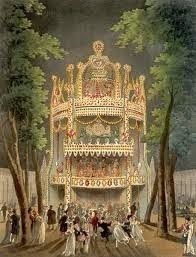 Illuminations -such as these at Vauxhall Gardens -
Illuminations -such as these at Vauxhall Gardens -were a popular attraction at a time when there was no electricity.One such time of celebration took place in the spring of 1789 to mark King George III’s recovery from severe mental illness. On several occasions between March and May it was recorded in London that night turned to day and “every house was illuminated not only in the principal streets but in lanes, courts and alleyways.”Contemporary newspaper reports give a flavour of the public mood.“London might truly be said to have exhibited one continual blaze of exultation…The inhabitants seemed to vie with each other who should give the most beautiful and picturesque devices [illuminations] …and…testify their loyalty in the most conspicuous manner.”Now I’m not suggesting Georgian illuminations are the direct ancestor of Christmas lights (actually that is a much duller story to do with the first Christmas trees) but the two things have an interesting parallel in that human nature never changes and in the 18th century, as now, people love to stare at pretty coloured lights.Have you decorated your house? Please leave a comment.
 With thanks to Cheezburger.com
With thanks to Cheezburger.com
Published on December 18, 2013 01:23
December 11, 2013
A Short History of Pantomime
As part of the 2013 Advent Blog Hop, I’ve taken the history of pantomimes as a theme and thought it would be fun to look into how such a quirky entertainment came about.
 Click for a link to the other stops.“He’s behind you!”That famous cry from the audience as the pantomime villain creeps up behind the principal boy…which brings back many happy memories of Christmas’ gone by. For my family it was a Christmas tradition to see a pantomime during the festive season – indeed now I have a family of my own, we continue this trend (As an aside, one year we took a relative and her American husband with us to the theatre. He was totally bemused and just didn’t know what to make of all the cross-dressing with actors playing the ugly sisters, and a beautiful actress masquerading as the hero - let alone all the bad jokes and audience participation. Our friend from the US claimed pantomimes are unknown in America – I’d be interested to know if this is the case or not. Comments welcome at the end of this post.)
Click for a link to the other stops.“He’s behind you!”That famous cry from the audience as the pantomime villain creeps up behind the principal boy…which brings back many happy memories of Christmas’ gone by. For my family it was a Christmas tradition to see a pantomime during the festive season – indeed now I have a family of my own, we continue this trend (As an aside, one year we took a relative and her American husband with us to the theatre. He was totally bemused and just didn’t know what to make of all the cross-dressing with actors playing the ugly sisters, and a beautiful actress masquerading as the hero - let alone all the bad jokes and audience participation. Our friend from the US claimed pantomimes are unknown in America – I’d be interested to know if this is the case or not. Comments welcome at the end of this post.)
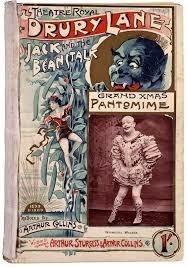
For those unfamiliar with the concept of pantomime here is the dictionary definition:“A funny musical play based on traditional children’s stories, performed especially at Christmas.”What this misses is the quirky, almost ludicrous element of pantomime, whereby men play women and women men, there is slapstick humour and the audience is expected to shout out in response to what they see on stage – a far cry from the usual hush of a theatre auditorium.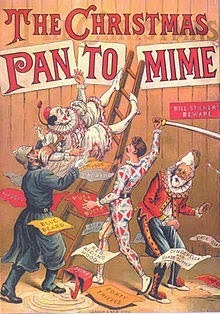
The clamour for something different emerged in early Georgian times with the public eager for novel entertainment, tricks and spectacle. The original pantomime pieces were short “Night scenes” – short scenes of slapstick comedy performed between the acts in London’s theatres. They heralded from Italy and a genre of performing art called commedia dell’arte which was brought to England by French players. Rivalry between the two London theatres of Drury Lane and Lincoln’s Inn Fields meant they were always on the look out for novelty. They adopted some of these scenes and incorporated them into longer stage shows and by 1723 the pantomime was born.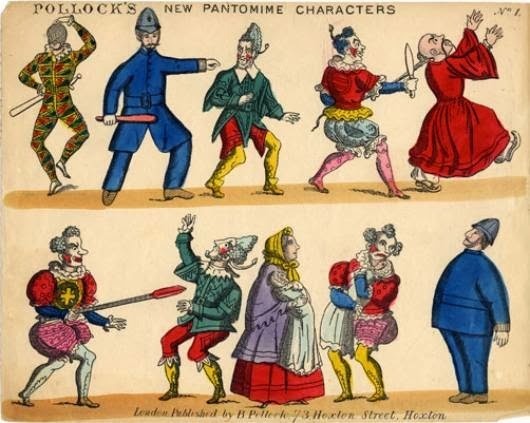
Drury Lane took an early lead with Harlequin Doctor Faustus, but Lincoln’s Inns Fields achieved more lasting success with The Necromancer. The later had singing, dancing, spectacular scenery and unusual special effects. Audiences flocked to see sights such as the miller getting hoisted in the sails of his windmill, Helen of Troy rising through the stage and a monstrous dragon the belched flames and roared.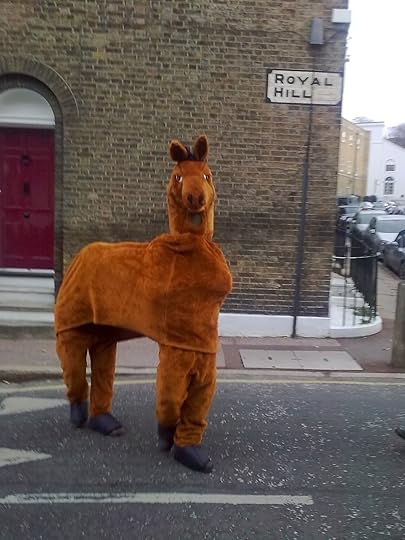 A pantomime horse on his way to the first
A pantomime horse on his way to the first
Greenwich, annual pantomime horse race (2013)It was a while later in the 1750’s that pantomimes became associated with Christmas entertainment, thanks mainly to David Garrick. Although he disliked the genre he was not averse to the money it brought in and mounted a special pantomime each Christmas. By 1806 the Covent Garden Theatre opened with Harlequin and Mother Goose, which is still regarded as the most famous pantomime of all time. It established some of the hallmarks of the modern panto when the pantomime dame was played by a man, in this case the actor and singer Samuel Simmons (1773 – 1819) and Joseph Grimaldi as Clown (1775 – 1846). Part of the popularity was that it poked irreverent fun at serious ballets such as those produced at the King’s Theatre, Haymarket.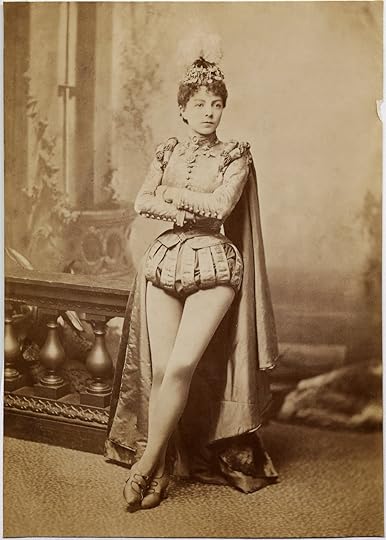 Vesta Tilley as a principal boyBy Victorian times the plots were inspired by European fairy tales or English nursery rhymes. Children were encouraged to attend as part of a family entertainment, for they enjoyed the fast pace and comedy of the play. Over the decades the panto evolved to contain such elements as a pantomime animal – usually a horse or a cow (a skin with two actors inside playing the back and front ends), a good fairy to guide the star-crossed lovers, risque double entendre, audience participation and even, in late Victorian times – a guest celebrity. Indeed, this carries on into the modern age where panto provides regular seasonal work for washed-up or B-list celebrities.
Vesta Tilley as a principal boyBy Victorian times the plots were inspired by European fairy tales or English nursery rhymes. Children were encouraged to attend as part of a family entertainment, for they enjoyed the fast pace and comedy of the play. Over the decades the panto evolved to contain such elements as a pantomime animal – usually a horse or a cow (a skin with two actors inside playing the back and front ends), a good fairy to guide the star-crossed lovers, risque double entendre, audience participation and even, in late Victorian times – a guest celebrity. Indeed, this carries on into the modern age where panto provides regular seasonal work for washed-up or B-list celebrities.

Don't forget to visit the other stops in the Virtual Advent Tour!
 Click for a link to the other stops.“He’s behind you!”That famous cry from the audience as the pantomime villain creeps up behind the principal boy…which brings back many happy memories of Christmas’ gone by. For my family it was a Christmas tradition to see a pantomime during the festive season – indeed now I have a family of my own, we continue this trend (As an aside, one year we took a relative and her American husband with us to the theatre. He was totally bemused and just didn’t know what to make of all the cross-dressing with actors playing the ugly sisters, and a beautiful actress masquerading as the hero - let alone all the bad jokes and audience participation. Our friend from the US claimed pantomimes are unknown in America – I’d be interested to know if this is the case or not. Comments welcome at the end of this post.)
Click for a link to the other stops.“He’s behind you!”That famous cry from the audience as the pantomime villain creeps up behind the principal boy…which brings back many happy memories of Christmas’ gone by. For my family it was a Christmas tradition to see a pantomime during the festive season – indeed now I have a family of my own, we continue this trend (As an aside, one year we took a relative and her American husband with us to the theatre. He was totally bemused and just didn’t know what to make of all the cross-dressing with actors playing the ugly sisters, and a beautiful actress masquerading as the hero - let alone all the bad jokes and audience participation. Our friend from the US claimed pantomimes are unknown in America – I’d be interested to know if this is the case or not. Comments welcome at the end of this post.) 
For those unfamiliar with the concept of pantomime here is the dictionary definition:“A funny musical play based on traditional children’s stories, performed especially at Christmas.”What this misses is the quirky, almost ludicrous element of pantomime, whereby men play women and women men, there is slapstick humour and the audience is expected to shout out in response to what they see on stage – a far cry from the usual hush of a theatre auditorium.

The clamour for something different emerged in early Georgian times with the public eager for novel entertainment, tricks and spectacle. The original pantomime pieces were short “Night scenes” – short scenes of slapstick comedy performed between the acts in London’s theatres. They heralded from Italy and a genre of performing art called commedia dell’arte which was brought to England by French players. Rivalry between the two London theatres of Drury Lane and Lincoln’s Inn Fields meant they were always on the look out for novelty. They adopted some of these scenes and incorporated them into longer stage shows and by 1723 the pantomime was born.

Drury Lane took an early lead with Harlequin Doctor Faustus, but Lincoln’s Inns Fields achieved more lasting success with The Necromancer. The later had singing, dancing, spectacular scenery and unusual special effects. Audiences flocked to see sights such as the miller getting hoisted in the sails of his windmill, Helen of Troy rising through the stage and a monstrous dragon the belched flames and roared.
 A pantomime horse on his way to the first
A pantomime horse on his way to the firstGreenwich, annual pantomime horse race (2013)It was a while later in the 1750’s that pantomimes became associated with Christmas entertainment, thanks mainly to David Garrick. Although he disliked the genre he was not averse to the money it brought in and mounted a special pantomime each Christmas. By 1806 the Covent Garden Theatre opened with Harlequin and Mother Goose, which is still regarded as the most famous pantomime of all time. It established some of the hallmarks of the modern panto when the pantomime dame was played by a man, in this case the actor and singer Samuel Simmons (1773 – 1819) and Joseph Grimaldi as Clown (1775 – 1846). Part of the popularity was that it poked irreverent fun at serious ballets such as those produced at the King’s Theatre, Haymarket.
 Vesta Tilley as a principal boyBy Victorian times the plots were inspired by European fairy tales or English nursery rhymes. Children were encouraged to attend as part of a family entertainment, for they enjoyed the fast pace and comedy of the play. Over the decades the panto evolved to contain such elements as a pantomime animal – usually a horse or a cow (a skin with two actors inside playing the back and front ends), a good fairy to guide the star-crossed lovers, risque double entendre, audience participation and even, in late Victorian times – a guest celebrity. Indeed, this carries on into the modern age where panto provides regular seasonal work for washed-up or B-list celebrities.
Vesta Tilley as a principal boyBy Victorian times the plots were inspired by European fairy tales or English nursery rhymes. Children were encouraged to attend as part of a family entertainment, for they enjoyed the fast pace and comedy of the play. Over the decades the panto evolved to contain such elements as a pantomime animal – usually a horse or a cow (a skin with two actors inside playing the back and front ends), a good fairy to guide the star-crossed lovers, risque double entendre, audience participation and even, in late Victorian times – a guest celebrity. Indeed, this carries on into the modern age where panto provides regular seasonal work for washed-up or B-list celebrities.
Don't forget to visit the other stops in the Virtual Advent Tour!
Published on December 11, 2013 02:07
December 4, 2013
A Personal Encounter with the Georgians

Last Saturday I had the great pleasure of visiting the British Library, London, and their ‘
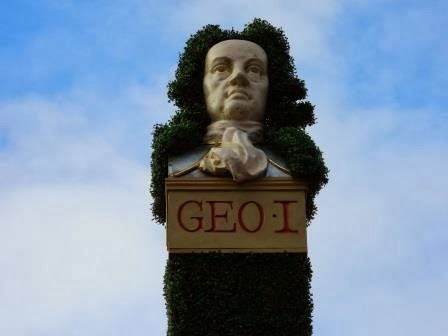 Author's own photoThe exhibition celebrates the 300thanniversary of George I acceding to the English throne (in 1714) – a new king whose heirs oversaw a momentous century of change. The impression left by the
Author's own photoThe exhibition celebrates the 300thanniversary of George I acceding to the English throne (in 1714) – a new king whose heirs oversaw a momentous century of change. The impression left by the
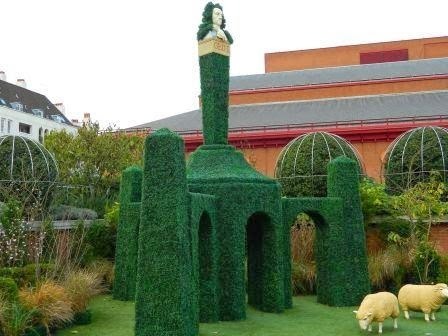 Author's own photoPerhaps it was because the venue was a library, but the importance of books and pamphlets in the 18thcentury struck me as incendiary. From the handbills promoting pantomimes, to step-by-step dance instructions; from magazines and fashion plates, to learned volumes on architecture – printed matter was key to spreading information beyond the privileged few to a wider audience. The 18th century was revealed as a time of ‘firsts’. Institutions that are still important today, such as the British Museum and the Royal Academy of Art, were founded. Most people know of Mrs Beeton and her famous Victorian cookbook, but have you heard of her fore-runner, Hannah Glasse who in 1747 produced the Georgian equivalent? Indeed, in 1754 Thomas Chippendale produced the first illustrated catalogue of furniture, and in 1765 Josiah Wedgewood opened his first London showroom selling fine china and porcelain.
Author's own photoPerhaps it was because the venue was a library, but the importance of books and pamphlets in the 18thcentury struck me as incendiary. From the handbills promoting pantomimes, to step-by-step dance instructions; from magazines and fashion plates, to learned volumes on architecture – printed matter was key to spreading information beyond the privileged few to a wider audience. The 18th century was revealed as a time of ‘firsts’. Institutions that are still important today, such as the British Museum and the Royal Academy of Art, were founded. Most people know of Mrs Beeton and her famous Victorian cookbook, but have you heard of her fore-runner, Hannah Glasse who in 1747 produced the Georgian equivalent? Indeed, in 1754 Thomas Chippendale produced the first illustrated catalogue of furniture, and in 1765 Josiah Wedgewood opened his first London showroom selling fine china and porcelain. 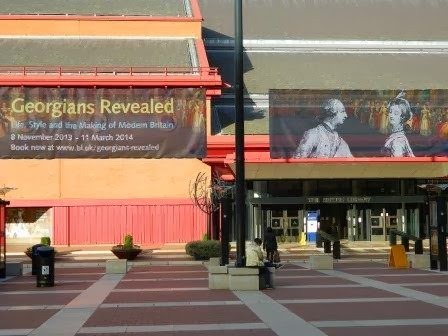 Author's own photoHobbies and pastimes that are familiar to us today had their root in the 18th century. For instance an early form of tourism, visiting the country house, was popular and some venues such as Lord Cobham’s estate in Stowe produced their own guidebooks. Ladies magazines such as the ‘Ladies Complete Pocket Book’ printed fashion plates with exhaustive descriptions of the latest gowns. This meant anyone could copy the designs and up-to-date fashion spread beyond the aristocracy. Fashion celebrities such as Fanny Murray were spawned, whilst printed cartoons by Rowlandson, Gilray and Cruikshank made it legitimate to laugh at ones superiors publicly in a way previously frowned on.
Author's own photoHobbies and pastimes that are familiar to us today had their root in the 18th century. For instance an early form of tourism, visiting the country house, was popular and some venues such as Lord Cobham’s estate in Stowe produced their own guidebooks. Ladies magazines such as the ‘Ladies Complete Pocket Book’ printed fashion plates with exhaustive descriptions of the latest gowns. This meant anyone could copy the designs and up-to-date fashion spread beyond the aristocracy. Fashion celebrities such as Fanny Murray were spawned, whilst printed cartoons by Rowlandson, Gilray and Cruikshank made it legitimate to laugh at ones superiors publicly in a way previously frowned on. 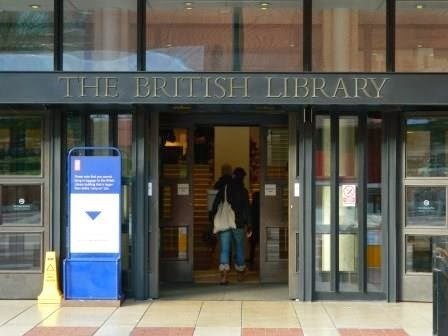 Author's own photoIt was also a time of huge growth for the city of London itself. Until the mid-18th century there were just five bridges across the Thames, but to feed the growing capital more were built. London expanded across fields and farms, many of today’s landmark squares were designed and created by architectural greats such as Adams, Palladio and Soane. Again, the magic of the exhibition was not just seeing contemporary prints of the buildings these architects created, but viewing the actual books they wrote and published. If you haven’t guessed by now, I felt thoroughly inspired by the ‘With thanks to Cheezburger.com
Author's own photoIt was also a time of huge growth for the city of London itself. Until the mid-18th century there were just five bridges across the Thames, but to feed the growing capital more were built. London expanded across fields and farms, many of today’s landmark squares were designed and created by architectural greats such as Adams, Palladio and Soane. Again, the magic of the exhibition was not just seeing contemporary prints of the buildings these architects created, but viewing the actual books they wrote and published. If you haven’t guessed by now, I felt thoroughly inspired by the ‘With thanks to Cheezburger.com
Published on December 04, 2013 00:48
November 27, 2013
18th Century Shoes
 My dream shoe...If only they had them in my size.Photo courtesy of Kobi Levi (Footwear Art)I have very big feet – but I am six foot tall – and recently I treated myself to a new pair of party shoes - not sadly the gorgeous cat shoes shown above.
My dream shoe...If only they had them in my size.Photo courtesy of Kobi Levi (Footwear Art)I have very big feet – but I am six foot tall – and recently I treated myself to a new pair of party shoes - not sadly the gorgeous cat shoes shown above. 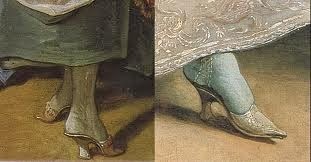 Shoes from 1742 (on the left) and 1731 (on the right) Since I’m currently researching life in the Georgian period (for a new series of romances) it seemed appropriate to post about shoes in the 18th century.
Shoes from 1742 (on the left) and 1731 (on the right) Since I’m currently researching life in the Georgian period (for a new series of romances) it seemed appropriate to post about shoes in the 18th century. 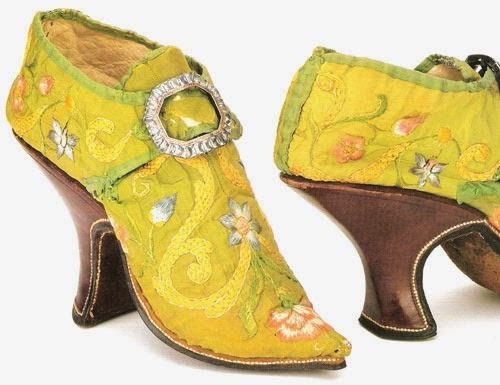 These early 18th century shoes have it all:
These early 18th century shoes have it all:embroidery, buckles and high block heels.
When George I acceded to the throne, ladies shoes were highly ornate. They were often made from fine brocade fabric, embroidered silks or painted leather and had detail such as curved heels and latchets (straps across the instep to keep the shoe on.)
Since the materials used were not made to withstand to mud and ordure of the street, the Georgian woman about town would slip a pair of clogs on over her shoes, in order to protect them.
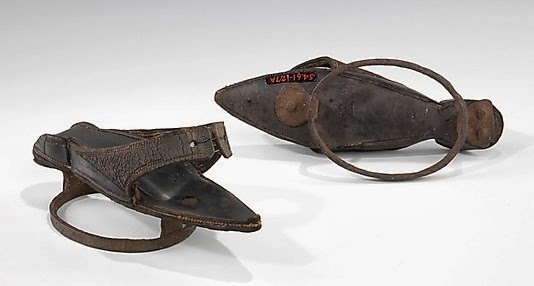 This is one example of a type of over shoe.
This is one example of a type of over shoe.The wearer slipped their more delicate slipper into the thong.
The metal hoop raised the lady above mud and street filth.
To ornament the shoes people added large bows, cockades, fabric flowers or jewelled buckles (real or paste stones depending on the wearer’s budget!) The buckles were detachable and stored in custom-made boxes to keep them safe when not being worn. The decoration included contrasting bindings, latchets and decorated heels.
 Shoes from 1700 - 1720
Shoes from 1700 - 1720Silk damask lined with kid leather.
A good example of a fashionable, Louie heel.In the early part of the 18thcentury both men and women wore high heels – the height of the heel equated with the wearer’s social status. The “Louie” or French heel was popular early on – these were carved from a wooden block and curved in to flare out at the base. In the 1770’s heels were short and narrow and gradually evolved into a shape similar to the modern kitten heel.
 This shoe from around 1770- 1785 shows the smaller lighter heel,
This shoe from around 1770- 1785 shows the smaller lighter heel,reminiscent of a modern kitten heel.The French Revolution in 1782 perhaps promoted a fashion for ‘flatties’ to show that everyone was born on the same level. By the 1810’s there was a stark contrast with the shoe of a hundred years earlier. In keeping with sleek regency gowns, the accompanying shoe was often light, flexible and held on with ribbons – the forerunner of the modern ballet pump.
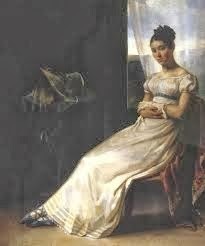 The flat, pump type shoe, secured with ribbons peek from
The flat, pump type shoe, secured with ribbons peek frombeneath the hem of this elegant lady's gown.The shoes themselves were ‘straights’ meaning there was no distinct left or right. Men were not immune to the vagaries of fashion.
 King Louis XIV of France -
King Louis XIV of France -heels and allIn the late 17th and early 18th century when wealthy gentlemen wore brightly coloured silks embellished with embroidery, the effect was set off with high heels.
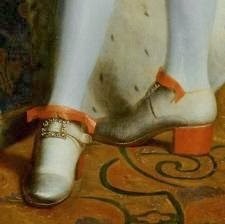 Detail from King Louis XIV's portrait showing red heels, buckles and bows.And finally, as the decades passed and men's clothing became more sober, so did their shoes. Heels lowered and the emphasis moved to become more practical with shoes made of leather and ornamented with removable buckles.
Detail from King Louis XIV's portrait showing red heels, buckles and bows.And finally, as the decades passed and men's clothing became more sober, so did their shoes. Heels lowered and the emphasis moved to become more practical with shoes made of leather and ornamented with removable buckles.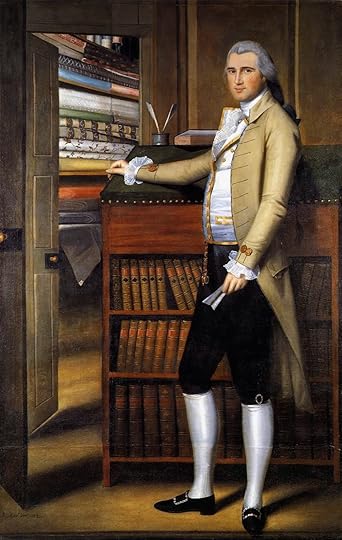 At the end of the 18th century, as men's clothes
At the end of the 18th century, as men's clothesbecame less flamboyant, so did their shoes.
Published on November 27, 2013 02:04
'Familiar Felines.'
Following on from last weeks Halloween posting, today's blog post looks at the unwanted image of cats as the witches familiar - from the Norse Goddess Freya to lonely women in the middle ages.
The full Following on from last weeks Halloween posting, today's blog post looks at the unwanted image of cats as the witches familiar - from the Norse Goddess Freya to lonely women in the middle ages.
The full post can found at:
http://graceelliot-author.blogspot.com
...more
The full Following on from last weeks Halloween posting, today's blog post looks at the unwanted image of cats as the witches familiar - from the Norse Goddess Freya to lonely women in the middle ages.
The full post can found at:
http://graceelliot-author.blogspot.com
...more
- Grace Elliot's profile
- 156 followers



